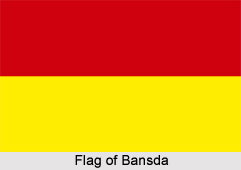 The Princely State of Bansda was one of the prominent states during the reign of the British Empire in India that was governed and administered by native rulers or Indian princes. The state was under the indirect control of the British Government of India. The princely state of Bansda was established around 1781 by Virsinhji. The region covered a total area of 557 sq km and had a total population of 54,735 in the year 1941. After Bansda was appointed as a princely state, it was incorporated as a part of the Baroda Agency and later under Western India States and Gujarat. The princely state of Bansda was honoured as a 9 gun salute state and the native rulers enjoyed criminal and civil jurisdiction, along with the authority to make their own legislation. The raja of Bansda state was an original member of the Chamber of Princes.
The Princely State of Bansda was one of the prominent states during the reign of the British Empire in India that was governed and administered by native rulers or Indian princes. The state was under the indirect control of the British Government of India. The princely state of Bansda was established around 1781 by Virsinhji. The region covered a total area of 557 sq km and had a total population of 54,735 in the year 1941. After Bansda was appointed as a princely state, it was incorporated as a part of the Baroda Agency and later under Western India States and Gujarat. The princely state of Bansda was honoured as a 9 gun salute state and the native rulers enjoyed criminal and civil jurisdiction, along with the authority to make their own legislation. The raja of Bansda state was an original member of the Chamber of Princes.
The princely state of Bansda, earlier known as Vasudevpur, was part of the erstwhile Surat Agency and is located in southeastern Gujarat. Bansda is bounded by the Navsari district of Baroda in the north, the Dangs (Amala, Vasurna and Pimpri) in the east, by Dharampur in the south and southwest and by the region of Surat in the northwest. The state comprised of a town and 86 villages in 1931.
History of Princely State of Bansda
The Solanki Rajputs were the ruling Chalukya family of Bansda state, who were styled Vansdia. In 1739, after the death of Raja Raibhanji, his two sons vied for the succession. Damaji Gaikwad, who acted as the arbitrator decided to divide the state in 2 equal parts, namely Bisanpur and Bansda. After the Treaty of Bassein in the year 1802, the British East India Company succeeded the Peshwa as the overlord of Bansda. The native ruler of the state had autonomous power to administer the internal issues of the state. But they maintained pleasant association with the British as they received protection and security in return.
Rulers of Princely State of Bansda
* Raja Sahib Udaisinhji II
* Raja Sahib Virsinhji I Udaisinhji (1716)
* Raja Sahib Raybhanji Virsinhji (1716- 1739)
* Raja Sahib Ghulabsinhji Raybhanji (1739- 1753)
* Raja Sahib Kiratsinhji Udaisinhji (1770- 1780)
* Raja Sahib Virsinhji II Kiratsinhji (1780- 1789)
* Raja Sahib Naharsinhji Virsinhji (1789- 1793)
* Raja Sahib Raisinhji Naharsinhji (1793- 1815)
* Raja Sahib Udaisinhji IV Raisinhji (1815- 1828)
* Raja Sahib Hamirsinhji Udaisinhji (1828- 1862)
* Raja Sahib Ghulabsinhji II Hamirsinhji (1862- 1876)
* Hh Maharaja Sahib Shri Pratapsinhji Ghulabsinhji (1876-1911)
* Hh Maharaja Sahib Shri Indrasinhji Pratapsinhji (1911)
* Shri Digvirendrasinhji Indrasinhji, The 22nd Raja Of Bansda



















